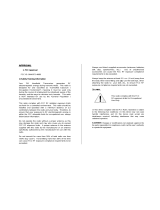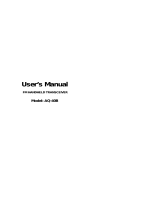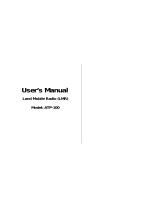Page is loading ...

CONTENTS
GENERAL FEATURES.................................................1
UNPACKING..................................................................2
OPTIONAL ACCESSORIES.........................................2
GETTING READY..........................................................2
DESCRIPTION...............................................................2
LCD PANEL...................................................................4
OPERATION ..................................................................5
ADDITIONAL FUNCTION.............................................6
CHARGER AND BATTERY..........................................7
SPECIFICATIONS .........................................................7
General Features
1. Ultra compact design & size
(102 x 50 x 36mm, 310g with high capable battery)
2. Heavy durable construction
3. 90 channels
4. Alphanumeric LCD display up to 6 characters
5. 38 CTCSS/ 83 CDCSS
6. PC Programmable, transferable by cloning
7. Time-out timer (TOT)
8. Busy channel lock-out (BCLO)
9. Battery saving mode
10. Low battery alert
11. 2/5 tones programmable
12. 12.5KHz/25KHz channel spacing programmable
13. DTMF PTT-ID
14. Button lockable
15. Talking range to 5 miles
16. Transmit output power High/Low
17. DC7.5V Ni-MH battery

Unpacking
Unpack and check that all items have been enclosed.
Packing contents: radioantennabattery pack (1,350
mAH) belt clip hand strap charger user’s manual
Optional Accessories
1. External earphone & MIC. (APE–10)
2. Additional battery pack (720 mAH, HM–720)
Getting Ready
1. Installation, Removal Belt Clip
Installation
: align the belt clip with
the plastic slots of the battery pack.
Slide the belt clip onto the battery
pack, pushing firmly until a click
heard.
Removal
: hold up the belt clip
release tab with a fingernail or a
coin (or like instrument). While
holding up the release tab, slide the belt clip out and
away from the battery pack.
2. Installation, Removal Battery Pack
Installation
: turn off the transceiver. Hold the transceiver
with the back of the unit facing up.
Place the battery pack against the
back of the transceiver so that the
tabs on the transceiver engage the
four openings in the battery pack.
Slide the battery pack toward the
top of the transceiver until a click
heard.
Removal
: turn off the transceiver.
Hold the radio with the back of the unit facing up. With
the thumbnail of your other hand slide the latch lever
down. While holding the latch lever down, slide the
battery pack down toward the bottom of the transceiver.
Separate the battery pack from the transceiver.
3. Installation Antenna
Rotate the antenna clockwise until
it is seated firmly.
*. Before your starting operation, make
sure the battery is fully charged.
Description

Power on / off and Volume Control Switch
Turn the transceiver on by rotating power on / off and
volume control switch clockwise and control the volume.
Channel Select Button
Select the desired channel with pressing Up and Down
button, pressing and holding down more than 1 second
makes the channel moving fast. And you can choose On
or Off in function mode.
PTT(Push To Talk) Button
Hold down to transmit, release to receive.
Function Button
Refer to “OPERATION” page 7.
Monitor Button
Press to monitor. Holding down over 2 seconds keeps
monitoring function on, and press shortly again or PTT
Button to stop.
LCD Display Panel
Refer to next page.
Tx / Rx Indicate LED (3 colors)
On Transmitting
Red
Blinking Low battery
On Receiving, monitoring
Green
Blinking Different sub-tone when receiving
Orange On
Initializing, programming and
cloning
Microphone
Talk 5~7Cm in distance during transmitting.
Speaker
External Earphone/MIC and Programming Jack Socket
Battery Pack
Helical Antenna

LCD Panel
DISPLAY FUNCTION
T
Sub-tone
SCN
Scanning
H L
Transmitt output power
Beep sound
!
Button lock
Channel
On
Off
PTT-ID
Abnormal
Abnormal
Program
Clone
Cloning finished
Cloning processing (moves
rightward)

Operation
1. Power Turn on / off and Volume Control
Rotate the Power on/off and Volume Control Switch
clockwise to turn power on, then the LED lights orange
and power–up tone is generated after about on second,
indicating the transceiver has passed the self–diagnostic.
When you turn on the transceiver, it comes same
channel and function with your last using. Rotate this
switch clockwise to increase the volume or
counterclockwise to reduce the volume. Rotate it
counterclockwise fully to turn power off.
2. Transmit
Choose the channel by pressing Channel Select Button
as you desire. Hold down the PTT Button and talk to
MIC in 5~7Cm distance. The LED lights red on
transmitting. Release the PTT button to stop
transmitting.
3. Receive
Choose the channel by pressing Channel Select Button
as you desire. The LED lights green on receiving. In
case the signal doesn’t match in using sub–tone, green
light blinks.
4. Monitor
Press the Monitor Button to monitor. Holding down
Monitor Button over 2 seconds keeps monitoring
function on, and press Monitor Button shortly or press
PTT Button to stop.
5. Scan
Press Channel Select Button ▲ while holding down
Function Button to start scanning forward increasing
channels.
In case Priority Scan not settled down
1) mem 1ch > mem 2ch > mem 3ch > …..
In case 1 cannel of Priority Scan is settled down
2) mem 1ch > pri ch > mem 2ch > pri ch > …..
In case 2 cannels of Priority Scan are settled down
3) mem 1ch > pri 1ch > pri 2ch > mem 2ch > …..
The transceiver stops scanning after detecting a signal
and returns a receiving mode in the channel if the signal
keeps for 2 seconds. Or re-start scanning automatically.
And if detecting a signal while scanning, but in case of no
matching sub-tone, re-starting scanning with a delayed
Press Channel Select Button▲ to skip the channel. And
if you press Channel Select Button▼ when the
transceiver is receiving a signal in a channel while
scanning, the transceiver doesn’t scan the same channel
in the next. And if you want to return the normal mode,
press Channel Select Button ▲ while holding down
Function Button to finish scanning.
When you press PTT Button while scanning, the
transceiver transmits in the channel which received a
signal last while scanning or LCD shows when it’s
turned on.
6. Dual Watch
The transceiver detects the channel LCD shows as well
as another channel set as a dual watch channel upon
“DW” mode.
7. Preference of Scan, Priority Scan & Dual Watch
Turn on holding down Channel Select Button▼. Then,
the LCD shows “SL-001”. And you can settle down which
channel can be scanned or not by pressing Function
Button in each channel while moving the channels
upward or downward with the Channel Select
Button▲▼. And press the PTT button to finish. Then
the LCD shows “P1-000”. Then, you choose a channel
with the Channel Select Button▲▼. Then press the
PTT button to finish. As well, “P2-000” by the above
same way. If you choose “000”, it doesn’t work.
The LCD will show “DW000” once registered “Priority
Scan”. Then, also you can register a Dual Watch channel
in same way as one of “Priority Scan”.
8. Beep Sound on / off

When you press Function Button once sign on LCD
blinks. (in case of being selected button lock function on
blinks) Press Channel Select Button to select the beep
sound on or off. Press PTT Button to finish selection.
9. Button Lock on / off
When you press Function Button twice, sign on LCD
blinks. Press Channel Select Button to select the button
lock on or off. Press PTT Button to finish selection. This
function prevents from changing the channel by
unintended pressing of Channel Select Button. Press
Function Button once, sign on LCD blinks. Select off
with Channel Select Button, then press PTT Button to
set off.
10. DTMF PTT–ID on / off
When you press Function Button three times, “dt” sign
on LCD blinks. Press Channel Select Button to select
DTMF PTT–ID on or off. Press PTT Button to finish.
11. Transmit Output Power H / L
While holding down PTT Button, press Channel Select
Button▲ to set high power (it shows ‘H’ on LCD) or
press Channel Select Button▼ to set low power (it
shows ‘L’ on LCD.
12. 2/5 Tone Decode (Selcall)
During initial radio programming by the technician this
radio can be configured for several different types of
decode operation. If a channel is selected that has
Selcall activated the radio will be muted until the proper
signal is received. When this occurs the radio can sound
a ringing type alert signal or a voice message maybe
heard. Depending upon the initial programming, pressing
the PTT may cause an automatic identifier to be sent.
When programmed for Selcall pressing the monitor and
function buttons at the same time can cause the Selcall
mode to be cancelled and generate an automatic
identification. Please have your radio technician or
dispatcher fully explain this operation.
Additional Function
1. Time–Out Timer (TOT)
It limits the amount of time you can continuously transmit on
a channel from 0~100 seconds by a programmer. There will
be a short pre–alert warning tone 4 seconds prior to the end
of the transmission. Then the transmission is terminated and
there will be a constant alert tone until you release the PTT
Button.
2. Busy Channel Lock–Out (BCLO)
It prevents from transmitting if any activity is detected on the
channel. Programmer can do this feature.
3. Power Saving Mode
If there is no transmitting and receiving for several time, the
transceiver takes the power saving mode automatically for
saving power.
4. Low Battery Alert
The LED will blink red whenever pressed the PTT Button if
the transceiver falls below a low voltage level. As well,
whenever you release the PTT Button on low voltage level,
there will be alert tone twice. Finally there will be alert tone
three times and “OFF” sign on LCD then the operation is
terminated.
5. Clo ni ng
You can clone from the transceiver to another. Connect the
transceivers with the cloning cable. While pressing both of
two Channel Select Button▲▼, turn the power on the
transceiver which want to be cloned (LCD shows ‘prog’ and
indicate LED lights orange). While pressing the Monitor
Button, turn the power on the original transceiver (LCD
shows ‘clon’ and indicate LED lights orange). Press the
Monitor Button of the original transceiver again to start
cloning (LCD shows ‘–‘moving right side). After 15 seconds
approximately, the cloning finishes (the original transceiver’s
LCD show ‘good’). Turn both transceivers power off and
disconnect the cloning cable.

On ChargingRed
Blinking Abnormal
battery
Green On Fully
charged
On Stand-by
for
charging
(rear cup)
Orange
Blinking Dischargi
ng
Charger and Battery
1. Battery (Ni-MH)
Voltage DC 7.5V
HM-1350 Over 8 hrsDuty time
(5-5-90)
HM-720 Over 4 hrs
2. Charger
Input power Free voltage (AC90~250V)
Charging time HM-1350 Appr. 100min
HM-720 Appr. 60min
Operating temperature 0ºC~55ºC
Connect the charger to electric power supply (free voltage
AC 90~250 V). Turn the transceiver power off and put into
front socket of the charger. The red light turns on during
charging and the green light turns on when finished. When
you put two batteries together, the front one charges first
then the rear one starts charging.
* When you put the battery on rear cup of the charger for
charging, the charger
checks voltage. If voltage
is under 7.4V, the charger
starts discharging for 4
minutes then checks
again. If voltage is still less
than 7V, it discharges until
voltage is 6V then starts
charging.
Specifications
AT-100 AT-200 AT-400
Dimension
(HxWxD)
102x50x32mm (720mAH Battery),
102x50x36mm (1,350mAH Battery)
Weight (With
Battery)
150g (243g/310g)
Operating Voltage DC 7.5V
Operating Temp.
-30 ~ 60
Battery Life (H/L)
720mAH Battery
1,350mAH Battery
(based on 5% Tx: 5% Rx: 90% STBY)
6hrs/8hrs
10hrs/15hrs
Channels 90
Privacy Codes 38 CTCSS, 83 CDCSS
Band Width 12.5KHz/25KHz programmable
Frequency Range Tx 136~150
(A)
150~174
(B)
216 -
223MHz
400~430
(A)
440~470
(B)
Rx Same as the above
FM Hum & Noise Tx -40 dB
Rx -40 dB
Rx Sensitivity -119 dBm (0.25uV)
Rx Spurious
Response
-70 dB -70 dB -70 dB
Rx Selectivity -70 dB -70 dB -70 dB
Rx Intermodulation -65 dB -65 dB -65 dB
Tx Power (H/L) 5W/3W 3W/2W 4.0W/2W
Tx Spurious Rejection
-65 dBc
Audio Power (8
Ω
)
500mW (Max.)
Frequency stability
±
2.5ppm
±
5ppm
±
2.5ppm
Standard units consist of
Desk Rapid/Trickle Charger ACR5-130/1.5 hrs
1,350 mAH Ni-MH Battery HM-1350
Helical antenna

User’s Manual
Land Mobile Radio (LMR)
Model: AT-100 A/B
AT-200
AT-400 A/B
Airtech Information & Communication Co., Ltd.
/



